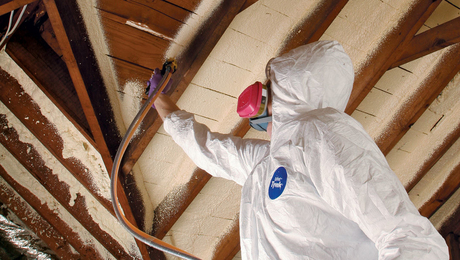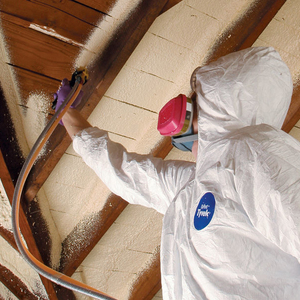Best practices for attaching roof joists to ridge beam?
My SE has shown a 3-1/2″ x 9-1/2″ PSL ridge beam for my 8:12 slope 2×10 roof joists (cathedral ceilings).
In studying the connection I see the roof joist plumb cut is 11-1/8″ tall so this isnt going to work well. I am likely going to substitute a triple 2×12 built up beam (with his blessing), which will provide a better match to the plumb cut. (My site also doesn’t suit trying to crane a 36′ PSL in place (I know I could splice it…)).
What are the best practices for attaching 2×10 roof joists to the face of a ridge BEAM. Lapping over the top is not an option. I am thinking either:
a) LUSSU210
or
b) Pressure blocks/blocking and face nailing roof joist to these. May also add framing angles like L90. Might add very short collar tie directly below the ridge beam too.
Any opinions, recommendations, photos?
Thanks
John



















Replies
Make the SE specify the connectors
If you went to the trouble of having a Structural Engineer figure out the right sized beam to use, I would ask him to specify the connector/nailing/bolting pattern too. That way, if it falls down, it's his problem too
The details of carpentry are not his forte...
I did all the beam, column, span selection & layout - he just reviewed and approved it. Basically its a city requirement presumably so the plan reviewer can absolve himself of any liability.
Normally you advice would be totally appropriate but not in this case.
It should be possible for mere mortals to attach a common framing element securely :-)
Vented roof?
Let the additional height of the rafter stick above the ridge.
If you are venting the roof, that will provide a vent space.
If you are going with a unvented system, it will allow for insulation above the beam, isolating one member from heat transfer (admittedly a small consideration in the overall scheme of your roof design.
Terry
I'd be inclined to want a saddle bracket, but they tend to be expensive.
The 210's should be OK, but you will have to make a birdsmouth cut for it to fit in the saddle.
should have said LSSU210
Those are slopeable so there is no need to reduce the effective joist depth by cutting a birdsmouth at the ridge end.
On of the advantages of a ridge beam is that there isn't any side push from the rafters if they are placed on a birdsmouth. You can actually take one half of the roof off completely without the other half pushing the roof over.
Why is notching over the top not an option? You NEED that space for the vbenting to the ridge vent from each rafter bay ( Yes, these are rafters, not joists)
You will never get what you need from 3-2x12 if a 3.5x9.5 is what is speced as needed. But if you change, go to 3 ea 1.75 x 11.25 laminated together in place.
There are other ways to get something in place than using a crane too.
Piffin
The term "roof
Piffin
The term "roof joist" might be a regional thing. Our building code defines them as follow:
"In these span tables the term "rafter" refers to a sloping wood framing member which supports the roof sheathing and encloses an attic space but does not support a ceiling. The term "roof joist" refers to a horizontal or sloping wood framing member that supports the roof sheathing and the ceiling finish but does not enclose an attic space."
For us a cathedral ceiling has roof joists.
Venting might be gable end vents - nice big architectural ones.
Your comments about the triple 2x12 not being a good substitute peaks my interest. I was under the impression a PSL beam was not substantially stronger than a similarly sized built up beam. Please let me know what you know about this and/or where I can read up on it.
PS I like cranes! We use them at work (up to 400t) and for smallish stuff they can do in 15 minutes what would take a 2 man crew the better part of a day to transport, raise, assemble, align/straighten etc a built up beam.
Thanks for any info.
John
Now explain how can you ventilate a cathedral roof with a gable end vent. I don't see that.
For info re replacing the psl, see your engineer
1.75" PSL is way stiffer than
1.75" PSL is way stiffer than dimension lumber. More resistant to both tension and compression forces - better seismic values as well. As other posters have mentioned, your engineer should be dealing with this. Pay him more if he did this review and stamp of your spec at minimum fee, but get it done right. And consider venting too. Gable vent in a cathedral ceiling will be very interesting...
...back to the original question
So back to my original question, what are the best practices for connecting roof joists to a ridge beam?
(Venting. Sorry I ever mentioned this. There is a small connecting attic which will vent the top ends of the cathedral ceiling roof joists. Trust me I have thought this one out.)
(Ridge beam. I thought I would get something ball parkish to take back to the SE. If its ridiculous like 6-2x12 then I can forget this option and not bother him. I will just increase the PSL from 9-1/2" deep to 11-7/8" deep - no need for additional SE involvement. Its too bad I didn't get anything useful from my question.)
Thanks in advance for any (on topic) advice.
John
Every bit of advice I donated was very much on topic.
But sorry, I can't trust you that you have any way of venting a cathedral roof at the end.
Actually the best way to do this DOESN'T require alot of connector metal.
If you put the birdsmouth on the top as well as the bottom, you gain 3 things
Each side of the roof is self supporting - so a load on one side is independent of the load on the other. If you wanted you you could do each half of the roof seperately.
where the rafters go over the ridge beam, you them extend past, then cut them at the slop of the opposite rafter top. So each rafter is offset 1.5" and can be face attached at the top. TADA - no more need for special connector hardware to keep the rafters from spreading off the ridge.
With the depth of the rafter on top of the ridge beam, you can insulate over it as well. Now you don't have a cold spot in the dead center of your ceiling.
I really have concerns about trying to a ridge to gable vent system. The problem I see is that the channels closer to the gable will flow more than the ones at the opposite end. Needless complexity - why can't you just put a ridge vent on top of that and let them vent independently?
lap over ridge beam
Paul
I do like that technique because its so simple and probably stronger. Likely have to detail securing the ridge beam because I don't want all that mass swinging around in the "big one". Collar ties along the bottom of the ridge beam seem in order as well as roof joist blocking.
My problem is I have a 8:12 slope either side of the ridge beam, but a big portion of the back is actually a shed dormer at 4:12. If done simplistically the sheathing ridgeline would shift towards the front of the house opposite the shed dormer.
I think I'd either have to cut oversized birdsmouths on the 8:12 roof joists (weakening them) or prop up the 4:12 roof joists on small 2x triangles.
If my roof were simpler I think I would go this route. As it stands though I believe my best solution is the LSSU210 slopeable hangers. I picked up one from the yard yesterday and they seem pretty skookum. Interestingly enough the back portion which bears against the ridge beam is only about 8-1/2" tall and had reinforcing ridges adjacent the joist end. There is no way a simple plumb cut 2x10 could be made to bear full depth against the ridge beam. Therefore as long as the geometry works out the 9-1/2" tall PSL should work (see attached pdf). I hope my BI sees it this way!
Thanks
John
With that dormer, putting the rafters on TOP actually makes MORE sense.
In your picture, the rafters on the 8:12 side are putting alot more sideways force on the ridge beam than the 4:12 rafters. All that pressure works to tip over those kneewalls on the left side of the attic.
Having them on the top provides 0 horizontal forces, so you can do whatever you want on each side independent of the other!
If you are really worried about notching, you could increas the depth, or you could go with this connector:
http://www.strongtie.com/products/connectors/VPA.asp
VPA - no thanks.
Paul
I had looked at the Simpson VPA1 before but I think it has a couple of fundamental limitations I am not comfortable with. 1) there are only two nails in the rafter. 2) the rafter ears are only 2" tall. This might be ok for the lower end of smaller rafters but doesn't seem suitable for use on both ends of a 2x10 - not without a lot of additional straps and blocking. (I think this connector is really meant for I-Joists, and that its not the best choice for dimensional lumber.)
My understanding is that with a non-sloped connection there is no horizontal force with a ridge beam. A birdsmouth meets this description. The LSSU210 although slopeable, seems to have enough rafter nails (7-9) that its effectively a non-sloped connection.
As the other poster mentioned this is all good discussion. It is interesting for me to see that no one commented on the use of pressure blocks. I think this is passe. However I did find one local builder using (alternating?) pressure blocks in a very similar PSL ridge beam / 2x10 roof joist installation. Please see attached photo. This seems like a bad idea, massive PSL not withstanding.
Anyway, thanks for all the feedback.
John
That PDF does not show a cathedral roof system. What you show is ventable with a gable end vent, but still not as efficiently as a ridge vent.
Nothing wrong with your attachment detail
Most of the discussion is good and it is really helpful for me specially the last reply.